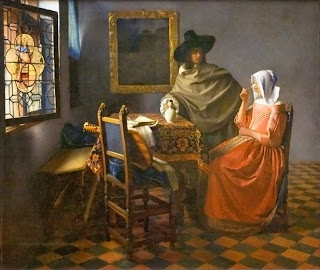Lyons Wier Gallery has established itself as one of the premier New York City art galleries promoting “conceptual realism.” Conceptual realism is to be contrasted with photo-realism or super-realism. In super-realism (a movement created in the 1960s), the artist often starts with an actual photo and painstakingly reproduces that image (usually) on a canvas. The reaction of a normal viewer to a work of super-realism is often: “Is that a painting!? It looks like a photo!” The second question is invariably, “Why did he/she do that?” or “Wow, how long do you think it took for that artist to paint this?”
An example of super-realism (Richard Estes):
That’s not to imply that super-realistic paintings are not without meaning or relevance. A person could argue that a super-realist was/is, basically, doing what Vermeer did – capturing and focusing on one instant in the flow of time to engender a better sense of the greater meaning of that moment and, perhaps, to better convey the transitory nature of our lives.
Conceptual realism, however, plays with realism to deliberately convey a greater meaning or concept. The work of Cobi Moules, in his show at Lyons Wier - Bois Just Wanna Have Fun - is a great example of conceptual realism. When you first look at one of his paintings in this show, you seem to see a huge mass of boys foraging around, standing around, rooting round or horsing around in an amazing landscape. Indeed, you might even mistake his pieces for examples of super-realism, until you look closely.
All the boys are, in fact, Cobi Moules. In fact, Moules’ paintings might be superficially interpreted as a wry commentary on the notion of trying to capture one moment in a super-realist piece. Moules seemingly captures many discrete moments within one landscape on one canvas. Indeed, one might feel an amazing contrast between the permanent and the transitory in each painting. Each particular landscape will be there for thousands of years (if not more), yet Moules, or anyone else wandering through, might be considered but a poor player strutting and fretting his hour upon the stage. The enormity of time each landscape will exist creates a sense of permanence or eternity which readily contrasts with the brief moment of our lives.
But Moules is shooting for more than this contrast between the permanent and the temporary – indeed, he seems to be fighting against this. After all, what’s more important: the actor or the stage? Moules’ pieces are, in fact, a wry commentary on the historically significant Hudson River School of painters, who can be considered, according to Moules, to be ideologically linked to certain strains of orthodox Christianity which condemn queer and transgender folks like himself as being ‘unnatural.’
Orthodox Christianity and the Hudson River School might have been saying, “Cobi, you don’t even belong on this stage!”, but Moules relishes his presence and exults in his multiple performances, engaging himself within a context of nature which DOES accept him. Moules' work shows that the stage and the actor are inseparable and that the diversity of human types on the stage of nature is a welcome presence.
Here's an example of Hudson River School painting. I'm not an expert on it, so I am not sure that I can agree that there might have been homophobic ties between it and orthodox Christianity. I think I understand Moules' argument, though, I guess. Basically here's what he said in the press release from Lyons Wier Gallery:
"I see a number of ideological links between their [Hudson River School] works and a specific current American Christian culture that was an integral part of my formative years; particularly in regards to ideas of purity and the honor of sacrificing one's selfhood for the glory of God. As a queer and transgender person, I seek to renegotiate my relationship with this upbringing and the act of being told I am 'unnatural' through such a pointed Christian lens."
Hudson River School stuff:
Here's an example of Hudson River School painting. I'm not an expert on it, so I am not sure that I can agree that there might have been homophobic ties between it and orthodox Christianity. I think I understand Moules' argument, though, I guess. Basically here's what he said in the press release from Lyons Wier Gallery:
"I see a number of ideological links between their [Hudson River School] works and a specific current American Christian culture that was an integral part of my formative years; particularly in regards to ideas of purity and the honor of sacrificing one's selfhood for the glory of God. As a queer and transgender person, I seek to renegotiate my relationship with this upbringing and the act of being told I am 'unnatural' through such a pointed Christian lens."
Hudson River School stuff:









No comments:
Post a Comment
Note: Only a member of this blog may post a comment.